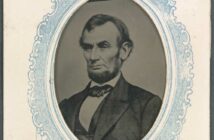All fruit dealers hope their fruits become famous. Joseph Sherfy likely never imagined his peach trees would become the most renowned peach orchard in Civil War history. But, like many Gettysburg civilians in 1863, the war appeared on their doorsteps, businesses, and farms—changing their lives, and landscapes, forever.
Sherfy purchased his land along Emmitsburg Road from his father in 1843. During the time of the battle, the property consisted of a brick farmhouse, a barn, a canning house, a hog stable, a corn crib and windmill, a bake oven and a privy, a dog house, and a wood shed. In addition, the Sherfy family owned a young 16-acre peach orchard that was just starting to flourish in a field across from the farmhouse. More mature trees in a four-acre lot stood at the corner of Wheatfield and Emmitsburg roads—these trees became famous as the Battle of Gettysburg raged through what is now commonly referred to as “The Peach Orchard.”
On the morning of July 1, 1863, the Sherfy family heard the first sounds of battle northwest of Gettysburg.
That night, Union troops moved into positions around the Sherfy farmhouse.
By July 2, the family remained inside their home until a Union officer urged them to retreat. Joseph’s mother-in-law, Catherine, experienced a dangerous encounter that morning. “A mini-ball fired from the Confederate side on the west had struck the board fence,” the family later recalled. The family, who consisted of Joseph and his wife Mary, their six children, and Mary’s mother, Catherine, decided to flee to the John Trostle farm southeast of Big Round Top and from there fled to Littlestown for the remainder of the battle.
It was a wise decision to flee the farm as heavy fighting raged around the Sherfy property and house until about 6:30 p.m. when Confederates broke through the Union position. The house was riddled with bullets, and the peach orchard became a battlefield. Wounded soldiers crawled into the house and barn for protection until the barn burned to the ground at the height of fighting.
Joseph Sherfy returned home on July 6 to a house and farm in shambles. He saw bloodstains on the floors and bullet holes inside and outside the house. The roof had several holes from artillery rounds, the dead had been buried in trenches around the yard, and dead horses plagued the property. The peach orchard was practically ruined and most of the young trees had been pulled out or knocked down. The barn and hog stable were burned, the windmill damaged, and several of the Sherfys’ animals were killed.
After the war, a federal law allowed citizens who experienced damage to file a claim for lost or destroyed property. Joseph filed three claims after 1881, totaling $2,500. He was ultimately denied, in part because the law mandated that damages had to be a result of the Union’s army actions. In Joseph’s case, the government agents felt the damage was caused largely by Confederates. Joseph stated in his claim, “When we returned to the house we found about everything gone. The house had been sacked, nothing hardly left…”
Despite the lack of assistance he received from the government, the Sherfy family replanted and rebuilt and for years sold peaches from their orchard, branding them as peaches from the original trees on the battleground.
The farm became a popular attraction for Battle of Gettysburg veterans. According to a member of the 687th PVI, Mrs. Sherfy had a wall in her house covered with photos of soldiers she met that fought on her property.
The Sherfys continued to live in the house until Joseph’s death of “typhoid malaria” at the age of 70. The National Park Service acquired the farm in 1969.
Today, the Sherfy property is still actively producing produce. The Gettysburg Foundation, with Gettysburg National Military Park and the Civil War Institute at Gettysburg College, harvest vegetables, fruit, and herbs in the Sherfy garden. Without digging into the battlefield landscape, volunteers gain the experience of using special techniques to grow crops from heirloom seeds. All harvested produce—2,000 pounds in 2015 alone—is donated to local food banks and community-based programs like Meals-on-Wheels and the Campus Kitchen.





2 Comments
Interesting to learn about the produce that is generated and then donated in modern days. I did not know the Sherfy home is now rented out, either.
I am the great, great grandchild of Joseph and Mary Sherfy. My paternal grandmother was Mary Pfeffer Brandt and my great aunt was Beatrice Pfeffer. Thank you for the very interesting old, old family stories. It was a tragic time for the Sherfy’s who were Dunkards, a pacifist religious group. My family visited the Gettysburg battlefield when I was a child but we were never told how much of the battles were fought on family land. It is a wonderful place to visit today.